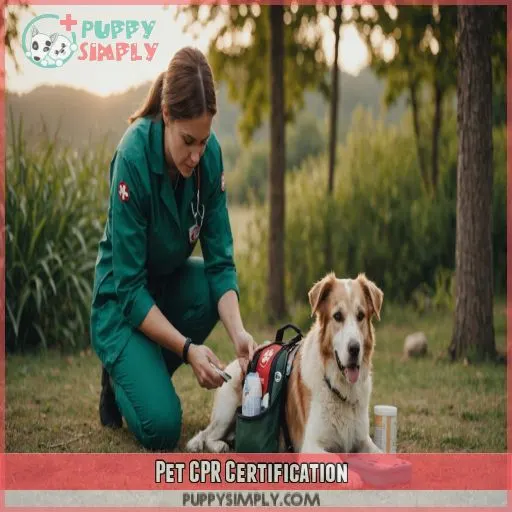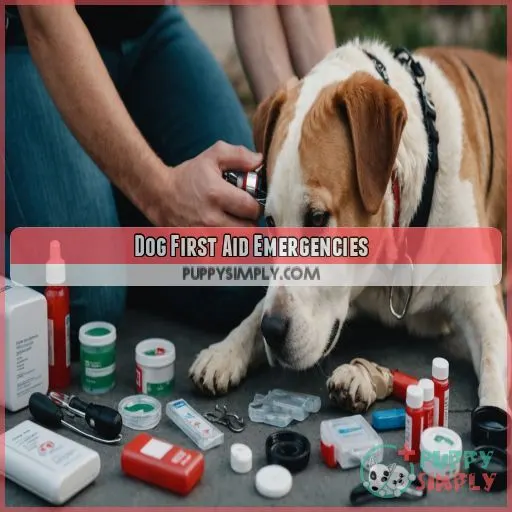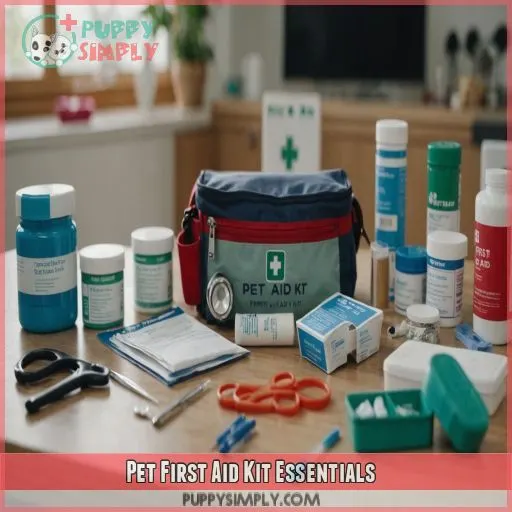This site is supported by our readers. We may earn a commission, at no cost to you, if you purchase through links.

By learning these essential skills, you’ll be empowered to act fast and confidently in an emergency. You’ll learn how to respond to common emergencies like bloat, heat stroke, and eye injuries, as well as master canine CPR techniques.
Table Of Contents
- Key Takeaways
- Pet CPR Certification
- Dog First Aid Emergencies
- Canine CPR Techniques
- Pet First Aid Kit Essentials
- Frequently Asked Questions (FAQs)
- What is the first aid for CPR on a dog?
- How much does it cost to perform CPR on a dog?
- What side do you lay a dog on for CPR?
- How long does pet CPR last?
- What are the benefits of online pet first aid courses?
- How do I check my pets vital signs effectively?
- What preventative care measures can I take for my pet?
- How can I recognize and respond to pet breathing emergencies?
- What is the importance of digital certification in pet first aid?
- Conclusion
Key Takeaways
- You’ll be empowered to act fast and confidently in an emergency by learning pet CPR and first aid, which can literally be a lifesaver for your furry friend. By mastering these essential skills, you’ll be prepared to respond to common emergencies like bloat, heat stroke, and eye injuries.
- Getting certified in pet CPR gives you the confidence and skills to save your furry friend’s life in an emergency. With online courses, you can learn at your own pace and access the course from anywhere. The certification process typically involves an 8-10 hour online course, a thorough assessment of your pet CPR and first aid skills, and a renewal process every two years.
- By knowing what to do in case of an emergency, you can stay calm, act fast, and give your dog the best possible care when they need it most. For example, you’ll learn how to respond to common emergency situations like bloat and gastric dilatation-volvulus (GDV), heat stroke, and eye injuries, as well as master canine CPR techniques to save your furry friend’s life.
- Having a well-stocked pet first aid kit and knowing how to use each item can help you respond to common emergencies and keep your furry friend safe and well. You’ll want to include essentials like bandages, antiseptic wipes, and a thermometer, and consider a customized kit that meets your dog’s specific needs, allergies, and health conditions.
Pet CPR Certification
As a dog owner, getting certified in pet CPR can give you the confidence and skills to save your furry friend’s life in an emergency. By learning pet CPR and first aid, you’ll be prepared to act quickly and effectively in case of a cardiac arrest, injury, or other life-threatening situation.
Course Structure and Learning Platform
- The online course typically spans 8-10 hours, divided into manageable modules.
- Online learning flexibility: access the course from anywhere, at any time, and learn at your own pace.
- Cost breakdown: expect to pay between $50-$200 for the entire course, depending on the provider.
- Instructor credentials: your teachers are experienced veterinarians or certified pet first aid instructors.
Examination and Certification Process
Now that you’ve completed the course, it’s time to take the certification exam, a thorough assessment of your pet CPR and first aid skills.
Renewal of Certification
To maintain certification validity, you’ll need to renew every two years; the online renewal process is straightforward and affordable, costing a minimal fee.
Benefits of Certification for Pet Owners
With pet CPR certification, you’ll enjoy peace of mind, a confidence boost, and increased knowledge to keep your furry friend safe and well.
- You’ll be empowered to respond effectively in emergencies, reducing panic and stress.
- Your vet partnership will be strengthened, as you’ll be able to provide key information and assistance.
- Your home will become a safer haven for your pet, thanks to your newfound knowledge and skills.
Career Opportunities for Certified Pet First Aid Providers
As a certified pet first aid provider, you’ll gain access to career opportunities like pet sitter, dog walker, shelter work, vet assistant, or animal rescue roles.
Dog First Aid Emergencies
As a dog owner, you’re probably no stranger to the occasional chaos that comes with sharing your life with a furry friend – and that’s exactly why learning dog first aid is a must. By knowing what to do in case of an emergency, you can stay calm, act fast, and give your dog the best possible care when they need it most (Source).
Common Emergency Situations for Dogs
As a dog owner, you want to be prepared for emergencies. Here are three common situations to know:
- Bloat and GDV: A life-threatening condition where the stomach twists, cutting off blood flow.
- Heat Stroke: A potentially fatal condition caused by overheating, often due to leaving your dog in a hot car.
- Eye Injuries: Commonly caused by accidents or fights, requiring immediate attention to prevent vision loss.
First Aid for Wounds and Bleeding
Now that we’ve covered common emergency situations for dogs, let’s discuss first aid for wounds and bleeding to help your furry friend heal quickly.
Treatment for Poisoning and Allergic Reactions
You’ve mastered wound care, now let’s tackle poisoning and allergic reactions – an essential part of dog first aid to save your furry friend’s life.
Recognizing and Responding to Seizures
Stay calm and act fast! Identify seizure signs, provide first aid, and create a response plan to promote your dog’s safety and well-being.
| Seizure Signs | First Aid Response |
|---|---|
| Convulsions or shaking | Clear the area of hazards |
| Loss of balance or | Gently turn your dog onto |
| consciousness | their side to prevent |
| Drooling or foaming | choking |
Cardiac Arrest and CPR for Dogs
Now that you know how to recognize seizures, let’s move on to cardiac arrest and CPR for dogs – a lifesaving skill of the utmost importance.
Canine CPR Techniques
You’re about to learn a really important skill that could save your furry friend’s life: canine CPR techniques. Mastering these techniques will empower you to act confidently and competently in a pet emergency, providing your dog with the best possible care when it matters most.
How to Perform CPR on a Dog
Save your furry friend’s life! Learn CPR for small, large breeds, puppies, and seniors. Use the right equipment for effective pet first aid.
Tips for Successful CPR
To boost CPR effectiveness, focus on proper chest compressions, breathing support, and regular pulse checks to keep your furry friend’s heartbeat and breathing going.
Common Mistakes to Avoid
To avoid common mistakes, stay calm, don’t over-react, and follow proper CPR techniques. Use a pet first aid app to guide you correctly.
CPR for Small and Large Breeds
When performing CPR on your dog, remember that breed size matters – adjust chest compressions and breathing support to suit your furry friend’s needs.
- Small breeds: Use shallower chest compressions (about 1/4 inch deep) and more rapid rescue breaths.
- Large breeds: Use deeper chest compressions (about 1/2 inch deep) and slower rescue breaths.
- Barrel-chested breeds: Use a slightly different hand position for chest compressions to accommodate their unique chest shape.
- Deep-chested breeds: Be mindful of their increased risk of cardiac arrest and adjust your CPR technique accordingly.
Special Considerations for Puppies and Senior Dogs
When performing CPR on puppies and senior dogs, consider their unique needs, such as dental care, joint issues, and medication, to make sure you’re being gentle.
Pet First Aid Kit Essentials
You’re taking a huge step in becoming a pet first aid hero by learning what to include in your pet’s first aid kit – it’s like having a safety net for your furry friend. With a well-stocked kit and some know-how, you’ll be ready to respond to common emergencies and help your dog feel better in no time.
Must-Have Items for a Pet First Aid Kit
Now that you’ve mastered Canine CPR Techniques, let’s assemble your pet first aid kit essentials, shall we?
How to Use Each Item in the Kit
Now that you’ve got your kit, let’s explore how to use each item, from bandage to thermometer.
Creating a Customized Kit for Your Dog
Create a customized kit for your dog by considering their specific needs, allergies, and health conditions precisely.
Restocking and Updating Your Kit
Now that you’ve customized your kit, you’ll want to regularly restock and update its contents periodically.
Travel-Sized Kits for On-the-Go Pet Owners
Now that you’ve restocked, consider a travel-sized kit for adventures with your furry friend on-the-go, always prepared.
Local Pet First Aid Classes and Workshops
Find local pet first aid classes and workshops with certified instructors for hands-on experience and affordable costs.
Staying Up-to-Date With Pet First Aid Best Practices
Stay updated on new pet first aid trends with online resources, expert advice, and regular practice drills.
Frequently Asked Questions (FAQs)
What is the first aid for CPR on a dog?
To perform CPR on a dog, start by checking for a heartbeat and breathing (Source). If the dog isn’t breathing or has no heartbeat, begin chest compressions and rescue breaths . Push hard and fast, about 100-120 compressions per minute, and give two breaths after every 30 compressions .
How much does it cost to perform CPR on a dog?
Giving your furry friend a second chance doesn’t have to break the bank. Performing CPR on a dog typically costs between $500-$1,500, depending on the vet and the pup’s size – think of it as a paws-itive investment!
What side do you lay a dog on for CPR?
When performing CPR on a dog, lay them on their right side.
This position helps keep their airway clear.
It allows for easy access to their heart and lungs, making it simpler to administer life-saving compressions.
How long does pet CPR last?
Let’s face it, every second counts! When performing pet CPR, you’ll need to keep going for about 20 minutes, or until you reach a veterinary hospital, to give your furry friend the best chance of recovery.
What are the benefits of online pet first aid courses?
By taking an online pet first aid course, you’ll gain confidence and essential skills to handle emergencies, enjoy flexible learning at your own pace, and receive digital certification – a great way to show off your new expertise!
How do I check my pets vital signs effectively?
In terms of your pet’s essential signs, ‘knowing the pulse’ of the situation is imperative. Check temperature, pulse, and respiration by gently feeling their heartbeat, counting breaths, and using a thermometer, and stay calm, you’ve got this!
What preventative care measures can I take for my pet?
You can take preventative care measures by scheduling regular check-ups, staying on top of vaccinations, and keeping your pet up-to-date on parasite control – it’s like giving them a shield against potential health threats!
How can I recognize and respond to pet breathing emergencies?
Imagine being your pet’s lifeline! Recognizing breathing emergencies is life-saving. Look for rapid or labored breathing, blue-tinged gums, or a collapsed posture. Act fast: call your vet or emergency services, and provide oxygen if possible.
What is the importance of digital certification in pet first aid?
You’ll want a digital certification in pet first aid to demonstrate your commitment to pet welfare and gain confidence in handling emergencies. It’s a valuable asset for pet owners and professionals alike .
Conclusion
When the chips are down, being prepared is key. Learning pet CPR and first aid for dog owners can be a lifesaver in emergency situations.
By mastering these essential skills, you’ll be empowered to act fast and confidently, giving your furry friend the best chance of survival.
With pet CPR and first aid training, you’ll be ready to respond to anything from bloat to cardiac arrest, ensuring your dog receives the care they need in a crisis.










